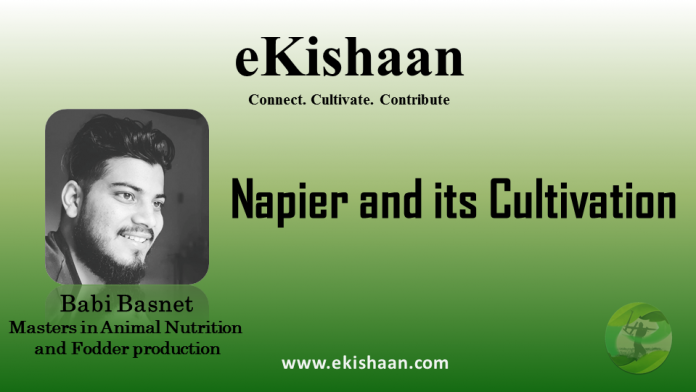Napier grass- Cultivation Practices, Diseases and their Management
1. INTRODUCTION
Napier grass (Pennisetum purpureum) is one of the important fast-growing perennial C4 grass species, tropical multipurpose forage crop. It is also called Elephant grass. A flowering plant belonging to family Poaceae that grows tall and forms large clumps like bamboo. Super Napier grass is most popular variety in Nepal. Napier grass is easy to establish and persistent; drought tolerant; suitable for cutting and very good for silage making. Advantages over others because of its high yielding capacity and ease of propagation, and management within a wide ecological range. Napier has anti-nutritive factor it causes milk fever by reducing calcium level on cattle body, so it should not be preferred two weeks before parturition. Napier grass can be more commonly distributed by vegetative cuttings and tillers. The grass cannot produce many seeds and those that are produced are normally very small, light, of poor quality and the spikelet are prone to shattering.
2. CULTIVATION PRACTICES OF NAPIER GRASS
2.1. Climate and soils
- Napier grass can be grown at altitudes ranging from sea level to 2,000masl.
- When grown at altitudes above 2000 m, growth and regeneration after cutting is slow and it may die due to frost.
- It does best in high rainfall areas, over 1500 mm per year.
- Napier grass can grow in almost any soils; but does best in deep, fertile, well-draining soils.
- It is however very drought tolerant and can be used as dry season reserve in dry areas.
2.2. Spacing
- The spacing may vary depending on the annual rainfall of the area; usually the higher the rainfall the closer the spacing.
- Root splits and canes are usually spaced at:
- 50 – 60 cm x 50- 60 cm in areas receiving rainfall of above 1800mm per year.
- 50-60cm x 90-100 cm is used in areas receiving 900 – 1800 mm of rainfall per year.
- 90-100 cm x 90-100cm in low rainfall areas receiving 700 – 900 mm of rainfall.
2.3. Establishment
- Napier grass is established in well-prepared land (ploughed and harrowed) from root splits, canes with 3 nodes or from whole canes.
- The material is planted 15-20 cm deep with splits planted upright, three node canes planted at an angle of 30-450 while whole canes are buried in the furrow 60-90 cm apart.
- Vegetative (stem cutting) propagation Whether root splits or canes are used, they should be sufficiently mature to tiller well and produce tall and high yielding forage plants.
- Cane planting materials should be obtained from plants about to flower where the stems are still green.
- Two methods may be used, namely: (i) conventional and (ii) Tumbukiza (micro-catchments)
I) Conventional method
- Plough and harrow the field well before planting
- Dig planting holes 15-12 cm deep, or spacing
- In each hole apply: 2 handfuls of farmyard manure (FYM) or a soda bottle full of DAP or both a handful of FYM and 1/2 soda bottle top of DAP
- Place 3 nodes piece of cane ensuring two nodes are covered or place a root split of Napier planting material in the hole
- Cover the planted material with soil
- Intercrop with forage legume
II) Tumbukiza technology (micro-catchments) method
- “Tumbukiza” pits for improved fodder productivity &gives higher herbage yields even during the dry season than the conventional method.
- Here planting is done in round or rectangular pits of 60 cm wide diameter and 60 cm deep, filled with a mixture of topsoil and manure in the ratio of 1:2. The rows of pits should be 60 cm apart.
- Plough and harrow the field well
- Dig pits with spacing of 60x 60 cm or 60 cm x 90 or 90 x 90 cm depending on moisture regime
- Mix 1 tin (20 liter) of top soil with 1 or 2 tons of FYM
- Put the soil-farmyard manure into the pit leaving 1 cm space at the brim
- Plant 5-10 cuttings/canes/root splits per hole
2.4. Intercropping with forage legumes
- Generally planting Napier grass with herbaceous legumes increases the dry matter yield and crude protein of the forage; those that are compatible and give high yields include:
- Giant vetch (Vicia dasycarpa) at higher elevations;
- Silverleaf desmodium (Desmodium uncinatum), greenleaf desmodium ( Intortum), stylo (Stylosanthes guianensis) and glycine (Neonotonia wightii) in high and medium altitudes;
- Centro (Centrosema pubescens), siratro (Macroptilium atropurpureum), butterfly pea (Clitoria ternatea), lablab (Dolichos lablab) and
- Stylo in the semi-arid coastal regions.
- This legume should be planted at a spacing of 1 m x 1 m and a seed rate of 1 -4 kg/ha near the grass rows or in between the rows.
- The legume helps to control the weeds and contribute to herbage production without competing with the grass.
2.5 Fertilizer application
- Requires regular application of nitrogen and phosphorus in the form of fertilizers or FYM because of its rapid growth and high yields.
Rates of application:
- 20 kg/ha/year of P in the form of either SSP or TSP at a rate of 100 kg/ha applied twice a year as a ring application around the stools at the beginning of the long and short rainy season on weeded plots.
- 75 kg/ha/ of N usually in the form of Calcium Ammonium Nitrate (CAN) at a rate of 300 kg/ha to be applied in splits after every grass harvest or in three equal doses in a year, during the long rains and short rains.
- Dairy cattle slurry: This is a mixture of cow dung, urine, and feed left over, available from the zero-grazing stable. The rate of application is 5.5 tons of DM/ha/year or 55 tons of liquid slurry. This should be buried between Napier grass rows to avoid loss of nitrogen by volatilization. The slurry is applied after the onset of long and short rainy seasons.
2.6. Weeding and inter-Row Cultivation
- Napier should be weeded regularly in order to maintain the grass in a vigorous and productive condition.
- It should be weeded as early as possible and at least twice after planting and kept weed free throughout growth especially after cutting.
- Aggressive weeds such as couch grass (Digitaria sp.) are best controlled during the dry season.
- Regrowth can be harvested when it reaches 2-3 ft. (60-90 cm) high which means a period of 6-8 weeks between cuts.
2.7. Potential Yields
- Yields on average Napier grass can give 12 to 25 tons/ha of dry matter yield.
- Under optimal management practices Napier grass can give yields 40 t/ha/year in high rainfall (1200 mm to 2400 mm of rainfall).
2.8. Harvesting
- Napier grass is ready for harvesting 3-4 months after planting and harvesting can continue at an interval of 6-8 weeks for 3 5 years depending on its management, soil fertility and soil moisture.
- Leave a stem length of about10 cm from the ground at harvesting.
2.9. Varieties
Super Napier, Elephant grass-1, NB-21, NB-5, NB-17, Gajraj, Puja Gaint, C.O. 03 (Hybrid Napier)
2.10. Feeding management
- Chop the harvested mixture of Napier grass and Desmodium to reduce wastage while feeding it to the animals.
- Do not graze animals directly on Napier grass.
- Feed 70 kg or 7 head loads of fresh Napier grass to a dairy cow per day.
- Two acres of Napier grass planted by the conventional method can give enough feed for 1 dairy cow for a full year.
- One acre of Napier grass planted by the Tumbukiza method can give enough feed for 2 to 3 dairy cows for one year.
2.11. Diseases
- Napier head smut
- The estimated yield loss due to smut disease ranges from 26 to 46%. Disease mainly spreads through wind and plant materials
- Categories: Fungal ,Causal organism: Ustilago kamerunensis
- Symptoms:Infected plants show thinner, shorter stems and produce few small size leaves. The shoot become hard and flowers prematurely. Head turns into smut.
Management
- Grow resistant varieties where available.
- Use disease-free planting materials.
- Keep the plants healthy by providing proper nutrients.
- Avoid using manure from livestock’s that have been previously fed with smut infected plants.
2. Napier Grass Stunt Disease (NGSD)
The disease causing stunting, curling/twisting of leaf tips reduces forage yield by 40 to 90%. The disease is mainly transmitted by plant and leaf hoppers and stem cuttings.
- Category: Viral,
- Causal organisms: Candidatus Phytoplasma oryzae (Ns-phytoplasma)
- Symptoms: The infected plants typically have small yellow leaves and short internodes. It produces large number of tillers. Plant become stunted and eventually die.
- Management: Use disease free healthy planting materials. Remove and destroy the infected plants. Follow crop rotation.

